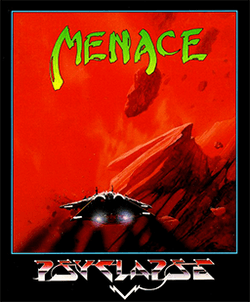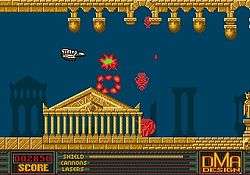Menace (video game)
| Menace | |
|---|---|
 Menace cover art, designed by Ian Craig | |
| Developer(s) | DMA Design |
| Publisher(s) | Psygnosis |
| Designer(s) | David Jones |
| Programmer(s) | Russell Kay |
| Artist(s) | Tony Smith |
| Composer(s) | David Whittaker |
| Platform(s) |
Amiga Atari ST, Commodore 64, MS-DOS |
| Release date(s) |
Amiga 1988 Atari ST, C64, MS-DOS 1989 |
| Genre(s) | Side-scrolling shooter |
| Mode(s) | Single-player |
Menace is a side-scrolling shooter video game developed by DMA Design and published by Psygnosis. It was originally released for the Amiga in 1988, and was ported for the Atari ST, Commodore 64, and MS-DOS in 1989. The game is set on the planet of Draconia, where players are tasked with destroying the planet's defence mechanisms in order to kill the harmful creatures.
The game was designed by David Jones, and was the first game developed by his company DMA Design. First developed in his bedroom at his parents' house, Jones began seeking an official development studio and publisher when the game was nearing completion. He eventually settled upon a publishing deal with Psygnosis, who first published the game in 1988 to positive reviews; praise was given to the game's graphics, sound and gameplay, while criticism was directed at its ports to inferior hardware. The game was commercially successful, selling over 20,000 copies.
Gameplay

Menace is a horizontal side-scrolling shooter that uses 2D computer graphics. Players control a powerful alien space fighter, moving through six stages on the planet of Draconia to advance through the game. Players use the ship's weaponry—lasers and cannons—to attack all advancing enemies,[1] and defeat the level's boss: a guardian of Draconia.[2] The six bosses act as Draconia's living defence mechanisms—the planet was created to habituate gruesome and harmful creatures,[1] of which there are over sixty,[3] participating in unlawful tasks.[1] In the game's levels, players discover space debris, which can be converted into upgrades for the ship.[2] The debris appears as tokens, and grants players additional weapons and upgrades, such as lasers, cannons, and improved ship and weapon power.[1] The ship also has a shield, which provides temporary protection from enemies; contact with enemies and walls depletes the shields, increasing players' vulnerability to death.[2]
Development and release
DMA Design was founded in 1987 by David Jones, Russell Kay, Steve Hammond and Mike Dailly, in Dundee, Scotland. Originally working under the name Acme Software, they began developing games for the Commodore 64 and Amiga. Jones began developing Menace under the working title CopperCon1, in his bedroom at his parents' house.[4] He was attending the Dundee Institute of Technology at the time. To publish the game in 1988, Jones first approached Hewson Consultants, where Andrew Braybrook played the game and recommended it to Hewson. When Jones was informed that Hewson wanted the game to be the "Amiga version of Zynaps", he realised that sales would be limited, and refused to sign the contract; despite this, Hewson had already promoted the game in Popular Computing Weekly, before the deal was officially dropped.[5] After signing a publishing deal with Psygnosis, Acme Software was renamed DMA Design.[6]
Tony Smith worked on some of the game's backgrounds and graphics,[5] while Jones designed the levels.[6] Jones decided for Menace to be a side-scrolling game after playing arcade games such as Nemesis (1985) and R-Type (1987).[7] Psygnosis could not decide a preference for the design of the player ship; as a result, Smith often re-designed the ship with many variations.[6] The team found difficulty porting the game to the Atari ST, due to the hardware's limitations with smooth scrolling. Brian "Biscuit" Watson, who the team met at a computer club in 1984, discovered a technique to overcome this difficulty. Other limitations included the fewer colours available with the hardware; Smith adapted his designs accordingly.[6] After completing his own game, Kay was assigned to port Menace to PC.[8] During development, the sound effects were temporarily replaced with those from Salamander (1986); Jones recorded the sound effects from the game, as Hammond and Dailly played. Prior to this, the temporary sound effects consisted of noises by Jones.[5] The game's final sound effects were designed by musician David Whittaker.[9] The cover art was designed by Ian Craig.[10]
At the end of development, the game was known as Draconia, before being renamed to Menace shortly before release, upon discovering that another game had the same title.[9] It was published in 1988 for the Amiga, and in 1989 for the Atari ST, Commodore 64 and DOS. The game generated a considerable amount of money for DMA Design,[9] allowing the company to develop more games.[11] The game sold 20,000 copies,[12] reportedly generating around £20,000.[13]
Reception
| Reception | ||||||||||||||
|---|---|---|---|---|---|---|---|---|---|---|---|---|---|---|
| ||||||||||||||
The game received mostly positive reviews from critics upon release, particularly for its gameplay, graphical design, and sound. Criticism was also directed at the game's ports, and the limitations met with the inferior hardware.[20] Jason Holborn of ST/Amiga Format wrote that the game "provides some of the best arcade action" in an Amiga game.[3]
Holborn of ST/Amiga Format called the gameplay "exceptional" and "addictive", stating that players will be "hooked for hours on end".[3] Ciaran Brennan of Computer and Video Games praised its replayability, writing that it has "enough depth built in to make it last".[2] Conversely, Zzap!64's Kati Hamza wrote that the gameplay is "rather poor", disliking the pace and level design, and Maff Evans in the same review called it "dull and unrewarding", pointing out the lack of excitement and reward.[19] The Games Machine condemned the "jerky scrolling" of the PC version,[17] while Rod Lawton of ACE called the gameplay of the Amiga version "stubbornly 8-bit".[14]
The game's graphics received positive reactions. Lawton of ACE called them "attractive",[15] and Holborn of ST/Amiga Format named them "beautifully stomach churning", calling Menace "one of the best presented games available".[3] While Zzap!64's Hamza felt that the Amiga version was "blessed with nice graphics", she wrote that the Commodore 64 version has "surprisingly weak presentation"; Evans similarly called the graphics "half-baked".[19] The Games Machine was disappointed by the graphics,[16] particularly identifying the limited colour capabilities of the Atari ST version.[18]
Reviewers praised the game's use of sound. ST/Amiga Format's Holborn lauded the soundtrack's appropriation to gameplay, calling it "brilliant", and writing that the game's speech and sound effects enhance the feel of the game.[3] The Games Machine favourably compared the soundtrack to Xenon (1988),[16] however noted that the sounds in the Atari ST version are "less clear",[18] and the PC sound effects are "pathetic".[17] Zzap!64 called the soundtrack "average", and wrote that the "pathetic [sound] effects add little atmosphere".[19]
References
- 1 2 3 4 "Menace : DMA Design Limited : Free Streaming". Archive.org. Internet Archive. 28 December 2014. Archived from the original on 3 October 2015. Retrieved 3 October 2015.
- 1 2 3 4 5 Brennan, Ciaran (November 1988). Lacey, Eugene, ed. "Menace". Computer and Video Games. Future plc (87): 40. Archived from the original on 3 October 2015. Retrieved 5 October 2015.
- 1 2 3 4 5 6 Holborn, Jason (November 1988). Taylor, Ben; Williams, Simon, eds. "Menace" (PDF). ST/Amiga Format. Future plc (5): 48–49. Retrieved 5 October 2015.
- ↑ Dailly, Mike (2004). "The History of DMA - Chapter 1, part 1". Mike Dailly. Archived from the original on 3 October 2015. Retrieved 3 October 2015.
- 1 2 3 Dailly, Mike (2004). "The History of DMA - Chapter 1, part 3". Mike Dailly. Archived from the original on 2 October 2015. Retrieved 3 October 2015.
- 1 2 3 4 Dailly, Mike (2004). "The History of DMA - Chapter 1, part 4". Mike Dailly. Archived from the original on 2 October 2015. Retrieved 3 October 2015.
- ↑ Wallis, Alistair (21 December 2006). "Playing Catch Up: GTA/Lemmings' Dave Jones". Gamasutra. UBM plc. Archived from the original on 3 October 2015. Retrieved 3 October 2015.
- ↑ Dailly, Mike (2004). "The History of DMA - Chapter 2, part 1". Mike Dailly. Archived from the original on 4 October 2015. Retrieved 5 October 2015.
- 1 2 3 Dailly, Mike (2004). "The History of DMA - Chapter 1, part 5". Mike Dailly. Archived from the original on 2 October 2015. Retrieved 3 October 2015.
- ↑ DMA Design, ed. (1989), Menace Instruction Booklet (PDF), Liverpool: Psygnosis, p. 2, retrieved 5 October 2015
- ↑ Hammond, Steve. "Scottish Games NET 1st Column". Steve Hammond. Archived from the original on 3 October 2015. Retrieved 3 October 2015.
- ↑ Dailly, Mike (2004). "The History of DMA - Chapter 4, part 1". Mike Dailly. Archived from the original on 3 October 2015. Retrieved 3 October 2015.
- ↑ "Grand Theft Auto V: Games visionary behind Scotland's biggest cultural export". Daily Record. Trinity Mirror. 17 September 2013. Archived from the original on 3 October 2015. Retrieved 3 October 2015.
- 1 2 Lawton, Rod (December 1988). Cooke, Steve; Kidd, Graeme, eds. "Menace". ACE. Future plc (15): 53. Retrieved 5 October 2015.
- 1 2 Cooke, Steve, ed. (November 1989). "Menace". ACE. Future plc (26): 98. Retrieved 5 October 2015.
- 1 2 3 Rose, Jon, ed. (December 1988). "Menace Spring Again...". The Games Machine. Newsfield Publications (13): 76. Retrieved 5 October 2015.
- 1 2 3 Kean, Roger, ed. (November 1989). "Version Updates: Menace". The Games Machine. Newsfield Publications (24): 85. Retrieved 5 October 2015.
- 1 2 3 Rose, Jon, ed. (February 1989). "Menace: Version Update". The Games Machine. Newsfield Publications (15): 28. Retrieved 5 October 2015.
- 1 2 3 4 Hamza, Kati; Evans, Maff (March 1989). Houghton, Gordon, ed. "Menace". Zzap!64. Newsfield Publications (47): 20–21. Retrieved 5 October 2015.
- ↑ McLaughlin, Rus; Thomas, Lucas M. (6 May 2013). "IGN Presents The History of Grand Theft Auto". IGN. Ziff Davis. Archived from the original on 3 October 2015. Retrieved 4 October 2015.